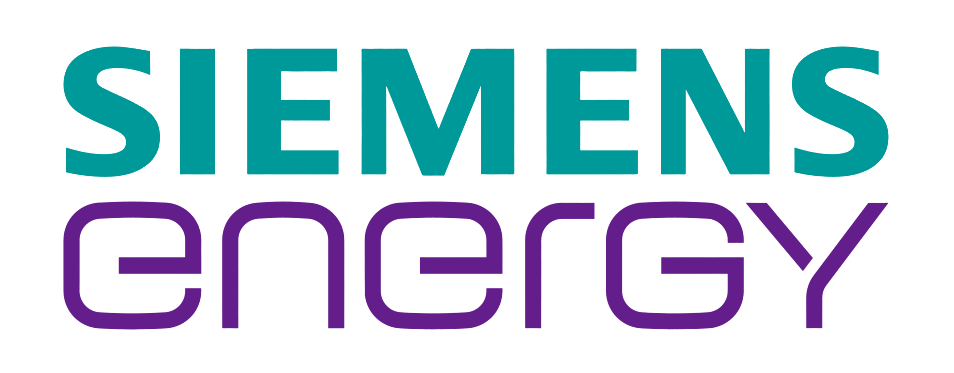Vehicle to Everything – Overview
Vehicle-to-everything (V2X), also known as co-operative systems, is a paradigm concerning vehicles’ ability to communicate dynamically with the traffic and infrastructure using wireless signals. The main objective is to share information between passengers, vehicles, and infrastructure to plan or take action to improve safety, sustainability, and efficiency of driving. Also, it tries to increase comfort convenience to an extent greater than a standalone, disconnected system.
V2X has several subsets, including vehicle-to-vehicle communication (V2V), vehicle-to-infrastructure (V2I), vehicle-to-pedestrian (V2P), vehicle-to-device (V2D), vehicle-to-grid (V2G), vehicle-to-network (V2N).
The ultimate aim of vehicle-to-everything (V2X) communication systems is facilitating safe and optimized driving that uses the available infrastructure efficiently. It will also support in future deployment of fully autonomous vehicles.
V2X can enable new functionalities in multiple categories, few examples include:
Monitoring
Applications in which vehicles will be capable of monitoring other vehicles & infrastructures, and communicate directly with each other to share data about their location, vehicle & road conditions, traffic flow, etc.
Safety
One of the main goals of V2X is to provide greater safety on frequently congested roads. It includes applications such as helping drivers to avoid collisions, managing vehicle’s blind spots, hazard warnings, approaching emergency vehicles, etc.
Compliance
V2X can also be used to ensure traffic rules compliance effectively. For example, it can warn the driver about speed limits, oversized vehicles, noise restrictions to be considered in specific zones like schools or hospitals, etc. There is also the potential to monitor real-time emissions or shared vehicles for personal safety.
Navigation
Analyzing real-time traffic information and route planning can be further enhanced by infrastructure-related real-time inputs like location and status of nearby gas stations, service stations, restaurants, etc.
Adaptive Infrastructure
One of the more crucial factors for policymakers & municipalities to promote V2X is to be able to use their existing infrastructure better. By connecting to transportation infrastructures to control & optimize the flow of traffic by controlling traffic lights, exits & mergers, and adaptive lanes, cities can provide a much higher value to its residents.
Autonomous Driving/ADAS
The current driving requires communication & collaboration with other users of roads & with infrastructure e.g., interacting with toll collection booths, etc. In a scenario of fully autonomous driving, vehicles must have the capability to take over this responsibility to communicate with other agents in the transportation system.
Infotainment and Others
Infotainment is an increasingly important aspect to the passengers, particularly in a future scenario with shared, autonomous driving. A much faster communication link will be needed to provide a seamless infotainment experience to consumers for a very wide choice of cloud-based entertainment options 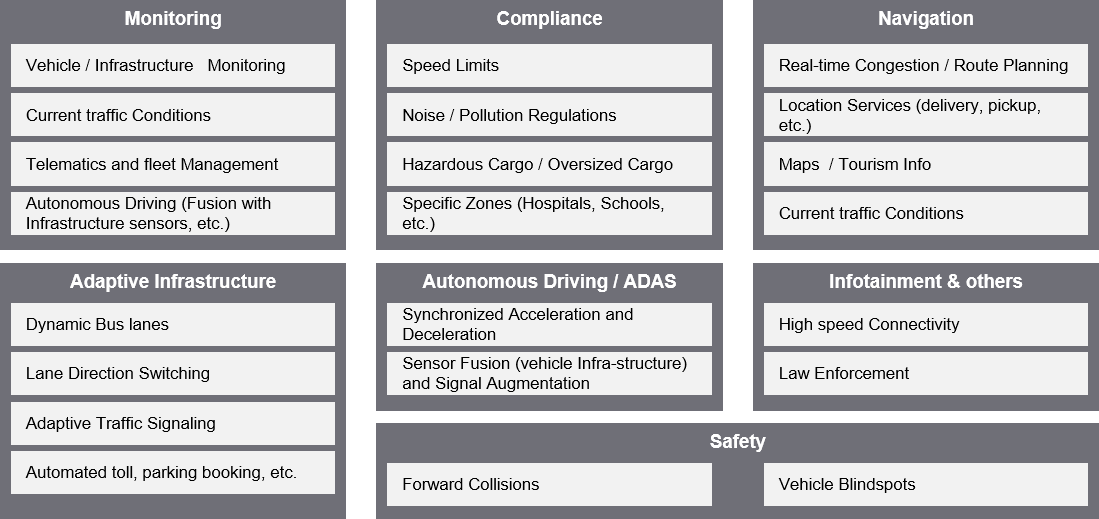
Competing Connectivity Technologies
Vehicular ad hoc networks (VANETs) are technologies that are precisely developed for vehicular communication. As digital content in the vehicle has increased, several communication technologies have emerged to deliver vehicle connectivity needs. The following technologies are or have been amongst the most viable communication technologies for connected cars:
Ad-hoc Communications: Dedicated Short Range Communication (DSRC)
Dedicated Short Range Communication (DSRC) is a Wi-Fi variant known as 802.11p that focusses on direct, short-range, and endpoint to-endpoint interoperability. It operates on the 5.9 GHz band in which information is shared between vehicles (V2V), like sending warnings to avoid collisions or sharing information about the traffic conditions. It also includes vehicles and infrastructure communication (V2I). For instance, when a traffic signal turns red, it will send alerts to the driver to adjust the vehicle speed. The purpose of this technology was to minimize external network requirements and maximize the number of vehicles and endpoints able to engage in data sharing by conveying basic safety messages such as vehicle position, speed, or direction.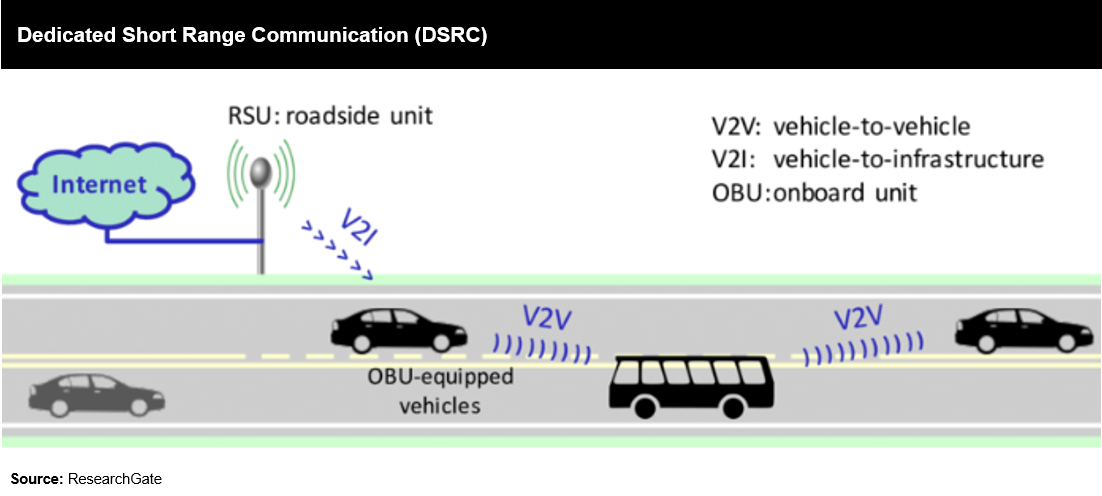
The U.S. FCC and European Telecommunications Standards Institute have been developing DSRC for the last 20 years. In 2015, Toyota and Lexus were the world’s first automakers to commercialize vehicles equipped with DSRC in Japan. Aptiv also introduced DSRC short-range radio communication devices in the 2017 Cadillac CTC, that shared locations, speed, and where the vehicle is heading.
However, the range that DSRC supports is up to 300m, which implies that the vehicle will not receive messages outside the range. Additionally, in dense areas, collisions may occur between messages when they are transmitted from two or more devices at the same time. Multimedia features like streaming videos from YouTube require high bandwidth, and so a DSRC network does not always suffice the requirement as it has low bandwidth.
Network Communications – A Challenger to DSRC: Cellular V2X (C-V2X)
Cellular V2X was designed to complement and magnify existing cellular capabilities. The slow pace of DSRC as a communication protocol created an opportunity for the 3rd Generation Partnership Project (3GPP) to develop a competing V2X communication standard, and it was standardized in 2017. C-V2X can use the same 5.9GHz radio channel as DSRC.
Along with connecting to other vehicles and infrastructures, it becomes more relevant in non-line-of-sight (NLOS) systems, where the sensors on the vehicle may, for instance, not detect a nearby pedestrian and may instead receive alerts from the cellular network. With a range greater than 450m, C-V2X results in longer reaction time to the driver than in DSRC communications.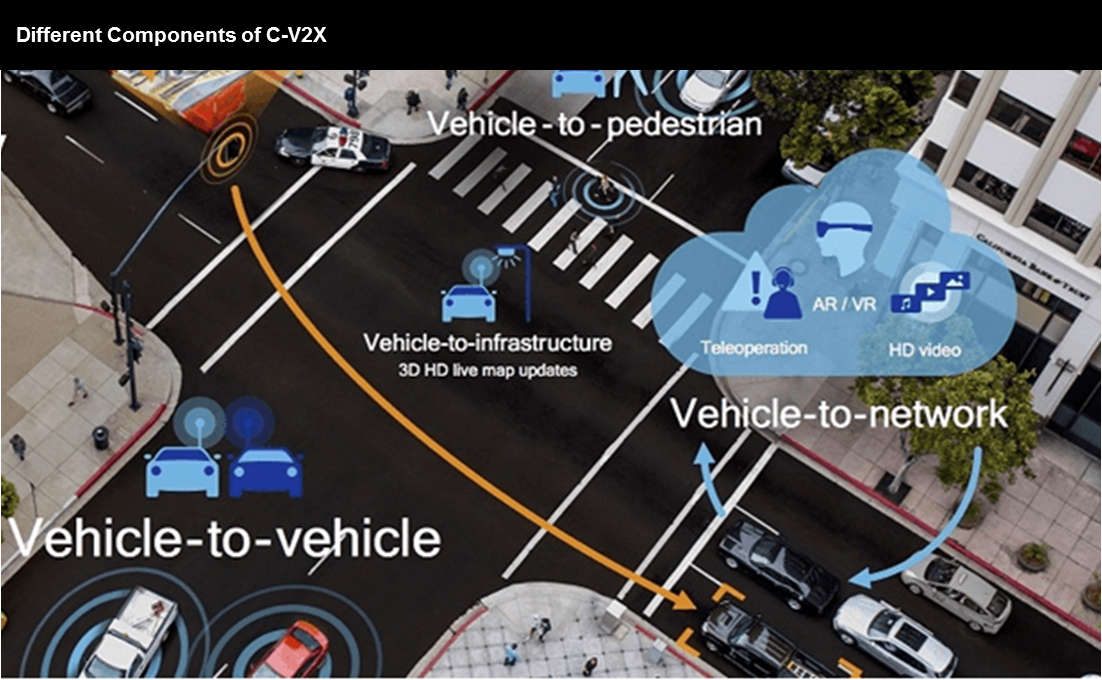
Prominent players in the telecom and automotive industries are exhibiting widespread acceptance of C-V2X. At CES 2020, Ford Motor Company announced that it would deploy C-V2X communications in all its new cars starting in 2022. Qualcomm Technologies and Audi also collaborated to demonstrate the world’s first Cellular Vehicle-to-Everything (C-V2X) technology operating across vehicles.
The Sixth Sense of Network Communications: 5G
A fifth-generation wireless network, or 5G, will amplify the future of connected vehicles. Cellular V2X technology is developed to be compatible with 5g. With the emergence of 5g, C-V2X technology will anchor plenty of advanced safety features to expedite the growth of connected cars. With its milliseconds’ latencies, 5G will increase the reliability of transferring messages. It will also enable new use cases with its high-bandwidth, and network slicing abilities.
The European 5GCAR Project, which is led by Sweden’s Ericsson, includes prominent telecom and automotive players to develop C-V2X network connectivity. According to Ericsson, the aim of the initiative is a “significant step forward in the development of connected vehicles.” Auto suppliers are already working aggressively to deliver solutions, e.g., Continental has developed a 5G hybrid platform integrating different Vehicle-to-Everything technologies (V2X).
Despite the technological benefits of 5G for automotive applications, some barriers still exist. High-cost improvements in infrastructure are the main stumbling blocks. Other challenges range from regulatory challenges, standardization, and cybersecurity.
Global Efforts for V2X Adoption
Efforts have been taken globally towards developing connected vehicles. The cellular vehicle-to-everything market is expected to witness a huge leap in demand over the coming years. The exhibit below summarizes geography wise efforts to implement V2X technologies: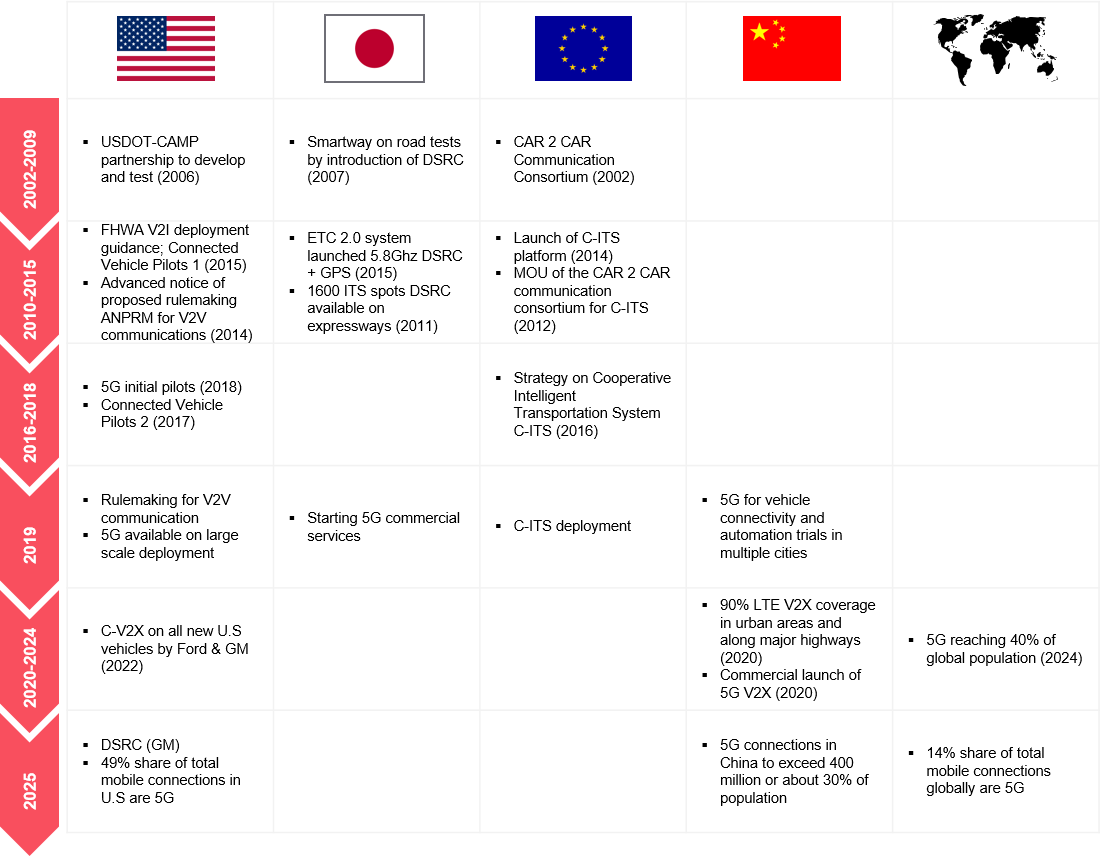
Future Outlook
The evolution of V2X communications will transform the automotive sector with new capabilities and product & service offerings. Analysts suggest that global revenues from the cellular vehicle-to-everything market are expected to reach nearly $62.7 billion by 2023. The anticipated market growth is attributed not only to the technology development happening in the automotive but also to the broader trends & emerging needs of all actors in the ecosystem – the consumers, the manufacturers, and the governments.
A new generation of customers consume increasingly more technology products & services, and these need will proliferate to their in-vehicle experience – to be more productive, safe, or be entertained. For institutional consumers, i.e. fleet operators, the importance further increases as V2X will not only help them increase the attractiveness of their vehicles for users, but it will also enable transparent and safe business operations with the possibility to further streamline & optimize processes.
For the automotive manufacturers & suppliers, the V2X technology will enable new features in the vehicles creating brand identity & much needed extra revenue for premium features. It will also provide manufacturers with an opportunity for additional & steady revenue streams. Lastly, better management of data in the long term will help them enhance the product and operations.
Finally, for the governments & regulators, particularly for the urban centers – V2X technology seems to be one of the last resort to manage traffic & public safety without huge spending on infrastructure projects. The high ROI nature of V2X implementations is very attractive for local governments as these projects can be small, have a fast turnaround, and high value for citizens – without disrupting too much the existing processes.
With leading enabling technologies nearing maturity and goals of various actors aligned, the future for the connected & cooperative V2X system is indeed set for explosive growth.
References
Need a thought partner?
Share your focus area or question to engage with our Analysts through the Business Objectives service.
Submit My Business ObjectiveOur Clients
Our long-standing clients include some of the worlds leading brands and forward-thinking corporations.
- © 2026 Cheers Interactive (India) Private Limited. All rights reserved. FutureBridge ® is a registered trademark of Cheers Interactive (India) Private Limited.































